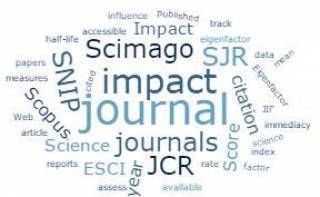There are a number of tools which can help you to assess the impact of a journal, or to compare journals.
The most widely known of these indicators is the Journal Impact Factor (JIF); other commonly used measures include the Source Normalized Impact per Paper (SNIP) and SCImago Journal Rank (SJR)
Note that journal-level metrics such as the impact factor should not be used as a proxy for the quality of individual papers in those journals.
Detailed recommendations on using metrics to compare journals are available as part of the UCL bibliometrics policy guidance, as is an in-depth look at the problems with the impact factor.
- Journal Impact Factor (JIF)
The Journal Impact Factor (JIF) uses citation data to assess and track the impact of a journal in relation to other journals, the impact factor is recalculated each year and is based on the mean citation rate during that year of the papers published in that journal during the previous 2 years.
Journal Impact Factors are listed within Journal Citation Reports (JCR), accessible via InCites\Web of Science. JCR covers science and technology, and the social sciences and is updated annually in two editions.
For the 2017 edition (and onwards), the JCR includes details of the citation distribution of articles, helping to show whether the JIF is driven by a large number of well-cited papers, or by a small number of highly-cited outliers.
JCR offers additional indicators of a journal's impact, including the Eigenfactor and Article Influence scores, although these are less commonly used.
- Scimago Journal Rank
The Scimago Journal Rank (SJR) is available from both Scimago and Scopus. Like the JIF, it is recalulated each year. It is based on the average number of weighted citations received during that year by the papers published in that journal during the previous 3 years. The citations are weighted using an algorithm which gives more weight to citations from more influential journals.
- Source Normalised Impact per Paper
The Source Normalized Impact per Paper (SNIP) is similar to the Journal Impact Factor, but is designed to be normalised by the different levels of citation among fields, avoiding one of the major pitfalls of the JIF. It tends to be high for journals which publish many review articles.
It can be found through Scopus, and on the CWTS Journal Indicators index.- Journal Immediacy Index
Other factors - such as turnaround time and acceptance rate - may be equally or even more important than the expected number of citations. These are rarely indexed and in some cases may not be easily discoverable. The journal immediacy index shows the average number of citations in the year of publication, which gives a sense of how quickly papers in that journal are picked up.
It is available through the Journal Citation Reports.

 Close
Close

